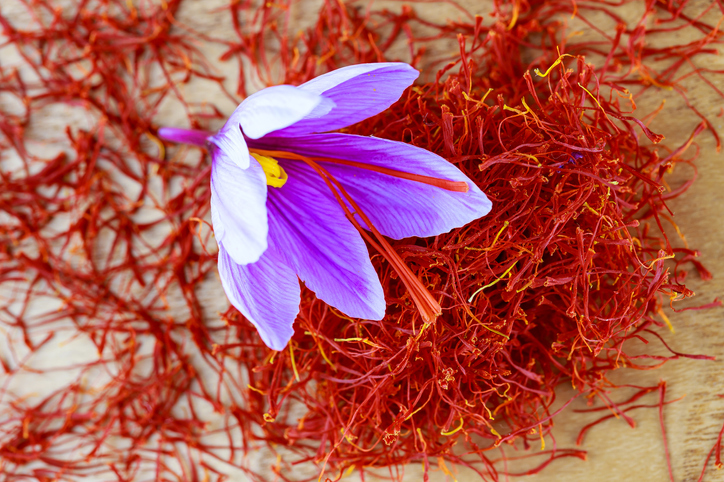In some cases, plant cell culture might enable the production of novel bioactives. In most cases, however, it’s about ensuring a consistent supply of high-value botanicals with supply chains increasingly threatened by unpredictable weather, political instability, and disease.
Rather than using sunlight, water, and soil to nurture fully-grown plants, a growing number of startups in this emerging field grow plant cells in bioreactors in conditions optimized for the rapid production of high-value compounds and secondary metabolites (think aloe vera, vanilla, cocoa polyphenols, saponins and even coffee).
At California-based Krokos Bio, which has just secured funding from Big Idea Ventures, founder and CEO Jacob Lang is focused on saffron, a spice derived from the stigmas of the Crocus sativus plant, renowned for its vibrant red/orange color, unique flavor, and hefty price tag.
Lang, who has worked in bioprocess development with microbial and animal cells, founded Krokos Bio in mid-2024 after becoming convinced plant cell culture could make economic sense for high-value botanicals.
“There’s a variety of rare botanicals that for one reason or another, are threatened,” he tells AgFunderNews. “It may be that most of the supply is concentrated in one area of the world, or really vulnerable to climate shocks, as you see in Madagascar with vanilla, where a cyclone can take out a giant chunk of global supplies.
“So it seemed like plant cell culture would be not a replacement, but a complement to conventional agriculture, serving as a buffer so that [traditional agricultural] supply chains aren’t completely threatened or decimated by one event.”
And saffron was the obvious place to start, he says. “I started reading about the drought in Iran, where the majority of the world’s saffron is produced, and the impact it was having on prices. And I was like, wow, this seems like a really great application for plant cell culture [a fact not lost on Ayana Bio, which is working on bioactives from saffron via plant cell culture with Korean firm Wooree Green Science].
“There are pros and cons, but plant cells have a lot of sort of advantages over animal cells. And plant cell culture is generally a lot cheaper as it doesn’t need a lot of expensive growth factors. However, the cells are quite shear sensitive compared to microbial cells.”

Where plant cell culture makes commercial sense
Krokos is still exploring the best bioreactor designs and materials, says Lang, who recently brought on Dr. Emma Skoog, formerly at plant cell culture startup California Cultured, as cofounder and CSO.
“So we’re looking at different materials [for bioreactors] such as plastic, but also looking at things like repurposing equipment from brewing and revamping it… using low cost alternatives instead of having to rely on biopharma equipment.”
While there are not scores of co-manufacturers with expertise in plant cell culture, there is a “growing number,” he claims. There’s a variety in the US, Europe, and also South America with potential to be scale up partners.”
Investors, meanwhile, are also becoming more au fait with the tech and its potential, he says, especially as some big names (Mondelēz, Barry Callebaut, Sparkalis, Lindt, Meiji) have got involved either as investors or via incubators.
“There’s growing interest, especially if you’re targeting higher value products, whereas anything [currently selling for] under $10/kilo that’s probably [very challenging]… although I’m not saying it’s not doable, just that I would personally be hesitant to explore something like that, unless you have access to really large-scale equipment.”
On saffron, he says, “We started by talking to a few suppliers and customers and understanding, okay, even low quality saffron is going for $1,000 per kilogram. So that’s an attainable price point if we can hit the quality that they’re expecting and we make it in a way that is food grade.”

How it works
To grow the ingredient via plant cell culture, he says, “We take samples from source plants, de-differentiate them [to return them to more of a stem cell-like state] and create a callus culture [an unorganized, undifferentiated mass of cells]. Those cells can then rapidly reproduce and divide and can grow in [liquid] suspension culture and scale up in a regular bioreactor. At the end of our process, we do re-differentiate the cells into stigma cells.
“With our platform, we’ve created a modification to that normal workflow, so we’ve added a step after that, that is going to result in pretty significantly higher yields and cut the R&D timeline. A lot of the plant cell culture work that’s done is on strain development, as with plant cells a big challenge is low productivity, and so selecting the best strain is a really big focus.
“What we’re developing, we’re expecting it to really cut down on that timeline, which I’d be happy to talk about at a later date as we’re in the process of filing a provisional patent.”
According to Lang, the same key compounds responsible for saffron’s distinctive culinary appeal (crocin, picrocrocin, and safranal, which provide its color, flavor, and aroma), are also those studied for health benefits around mood, sleep, metabolic health and appetitive suppression.
“We’re developing a food grade saffron powder for culinary uses, but it will contain all three compounds.”
As to how tunable plant cell culture process is, he says, aside from nailing down a solid cell line, there are plenty of levers to pull in the bioprocess, from altering media components that elicit certain responses in the cells, to changing the temperature, pH, and oxygen levels.
“The low productivity of plant cell culture has been what has held things back a lot of the time, but there is a variety of things you can do to make a really favorable environment for the cells to produce a lot of what you want.”
‘Potentially viable unit economics as soon as pilot scale’
Given the high cost of saffron, he says, the unit economics of plant cell culture look pretty favorable even at relatively small scale. “We’re looking at potentially viable unit economics as soon as pilot scale of around 1,000-L, which is really exciting.”
Big Idea Ventures has been an “exceptional” partner, he adds. “They have a lot of connections with large ingredient corporates and the food technology and ingredient space, as well as other startups in their network and they’ve been super helpful in getting us in front of the right people.”
As for the business model, he says, it will make sense to partner with ingredient companies and distributors that already understand the market and have established partnerships. On manufacturing, meanwhile, working with co-manufacturers is key due to investors’ reluctance to fund capex projects. “Co-manufacturing can be quite pricey, but for us, we expect it to be economically viable,” he adds.
For the plant cell culture segment more generally, he says, beginning with a very clear understanding of what markets and products make sense is critical “before even starting the technical work… You don’t want to spend three years making something you won’t be able to sell.”
From a technical perspective meanwhile, “Getting healthy, stable calluses is a challenge… and there’s a million opinions on how to go about it and then scale up.”
Further reading:
Could plant cell culture pave the way for the next generation of antioxidants and antimicrobials?
🎥Plant cell culture startup Green Bioactives preps for first commercial launches in 2026
🎥 Cocoa, minus the beans: California Cultured plans launch in 2026
🎥 Futureproofing the botanicals supply chain with plant cell culture startup Ayana Bio






